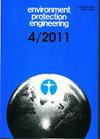Assessing some advanced oxidation processes in the abatement of phenol aqueous solutions
IF 0.4
4区 环境科学与生态学
Q4 ENGINEERING, ENVIRONMENTAL
引用次数: 2
Abstract
In this work, phenol oxidation in aqueous solution promoted by the effect of the oxidizing agents H 2 O 2 , O 3 and UV radiation and their synergy in four different advanced oxidation processes (O 3 , O 3 /UV, H 2 O 2 /O 3 and O 3 /H 2 O 2 /UV) were assayed. Studies were performed with a closed-loop hydraulic circuit set up with a relatively high volume of solution (500 cm 3 ) during 90 min of treatment time. Parameters such as concentration for oxidizing species, pH, presence of UV irradiation were evaluated. The resulting degradation efficiencies were evaluated using GC-MS. The agents here used were se-lected considering their ease of handling and low toxicity, generation of deposited matter or sludge, so a filtration treatment for the analysis of the samples was not required. In all cases, it was observed that with increasing treatment time better degradation efficiencies were obtained. The best results were obtained with the combination of O 3 /H 2 O 2 /UV where up to 95% degradation was attained at pH 9, which is due to active species generated in the process, e.g., O 3 and OH , on the contaminant. SPE was performed for determining the presence of several by-products, mainly: catechol, resorcinol and hy-droquinone, which were identified.评价了几种高级氧化法在苯酚水溶液处理中的应用
本文研究了氧化剂h2o2、o3和紫外线对苯酚在水溶液中的氧化作用,以及它们在o3、o3 /UV、h2o2 / o3和o3 / h2o2 /UV四种不同高级氧化过程中的协同作用。在90分钟的处理时间内,使用一个闭环液压回路设置相对高体积的溶液(500 cm 3)进行研究。评价了氧化物质浓度、pH值、紫外辐照等参数。采用气相色谱-质谱法评价降解效率。这里使用的药剂是经过筛选的,考虑到它们易于处理,毒性低,不会产生沉积物质或污泥,因此不需要对样品进行过滤处理。在所有情况下,观察到随着处理时间的增加,获得了更好的降解效率。在pH值为9的情况下,o3 / h2o2 /UV组合获得了最好的结果,降解率高达95%,这是由于该过程中产生的活性物质,例如o3和OH -,在污染物上。用固相萃取法测定了几种副产物的存在,主要有儿茶酚、间苯二酚和对苯二酚。
本文章由计算机程序翻译,如有差异,请以英文原文为准。
求助全文
约1分钟内获得全文
求助全文
来源期刊

Environment Protection Engineering
环境科学-工程:环境
CiteScore
0.80
自引率
0.00%
发文量
9
审稿时长
12 months
期刊介绍:
Water purification, wastewater treatment, water reuse, solid waste disposal, gas emission abatement, systems of water and air pollution control, soil remediation.
 求助内容:
求助内容: 应助结果提醒方式:
应助结果提醒方式:


